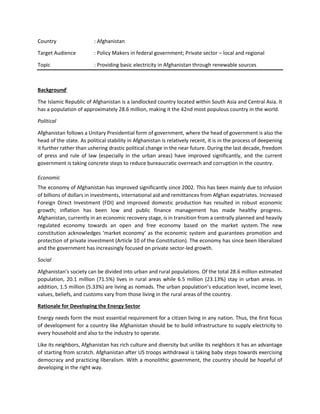
Final project finance for development - Afghanistan
- 1. Country : Afghanistan Target Audience : Policy Makers in federal government; Private sector – local and regional Topic : Providing basic electricity in Afghanistan through renewable sources Backgroundi The Islamic Republic of Afghanistan is a landlocked country located within South Asia and Central Asia. It has a population of approximately 28.6 million, making it the 42nd most populous country in the world. Political Afghanistan follows a Unitary Presidential form of government, where the head of government is also the head of the state. As political stability in Afghanistan is relatively recent, it is in the process of deepening it further rather than ushering drastic political change in the near future. During the last decade, freedom of press and rule of law (especially in the urban areas) have improved significantly, and the current government is taking concrete steps to reduce bureaucratic overreach and corruption in the country. Economic The economy of Afghanistan has improved significantly since 2002. This has been mainly due to infusion of billions of dollars in investments, international aid and remittances from Afghan expatriates. Increased Foreign Direct Investment (FDI) and improved domestic production has resulted in robust economic growth; inflation has been low and public finance management has made healthy progress. Afghanistan, currently in an economic recovery stage, is in transition from a centrally planned and heavily regulated economy towards an open and free economy based on the market system. The new constitution acknowledges ‘market economy’ as the economic system and guarantees promotion and protection of private investment (Article 10 of the Constitution). The economy has since been liberalized and the government has increasingly focused on private sector-led growth. Social Afghanistan’s society can be divided into urban and rural populations. Of the total 28.6 million estimated population, 20.1 million (71.5%) lives in rural areas while 6.5 million (23.13%) stay in urban areas. In addition, 1.5 million (5.33%) are living as nomads. The urban population’s education level, income level, values, beliefs, and customs vary from those living in the rural areas of the country. Rationale for Developing the Energy Sector Energy needs form the most essential requirement for a citizen living in any nation. Thus, the first focus of development for a country like Afghanistan should be to build infrastructure to supply electricity to every household and also to the industry to operate. Like its neighbors, Afghanistan has rich culture and diversity but unlike its neighbors it has an advantage of starting from scratch. Afghanistan after US troops withdrawal is taking baby steps towards exercising democracy and practicing liberalism. With a monolithic government, the country should be hopeful of developing in the right way.
- 2. Any country’s engine of growth has to be the industry and for industries to operate they need energy. Therefore, for Afghanistan to promote infrastructure development in industries either locally or by inviting FDI, they need to ensure and enable a stable environment with uninterrupted electricity. Why invest in Energy?ii The overall energy sector goals include rehabilitation and expansion of the public power grid and attraction of private investments. Economic growth demands increased energy consumption; therefore, there is a direct relationship between per capita GDP and per capita energy consumption. Afghanistan currently imports substantial amount of energy for its domestic consumption. In terms of production, Afghanistan currently produces 600 million watts of hydro-power electricity, and there is huge potential of producing up to 23,000 million watts of hydro-power electricity. The demand for electricity is increasing steadily, and it is estimated that Afghanistan would require 3,000 MW of electricity to suffice its needs by 2020. Other than meeting its own demand, it has a great potential to export electricity to the neighbors and regional countries. Proposed Solutions 1. Involving non- resident locals to build startups in Biomass and renewable energy 2. Utilizing ODA and other forms of grant to effectively allocate to building RE projects 3. Attract private sector foreign direct investment As mentioned earlier the entire nation has taken baby steps towards development, hence the country can learn from other developed countries in the world. Singapore for instance can be a good inspiration to emulate as a model of development. Deregulation and openness with a stable government is like the holy grail for private sector companies to invest. The FDI can be made in Renewable Energy infrastructure development. As the country has a large nomadic and spread out demographics, the most favorable option would be to invest in off-grid solar energy. The statistics for renewable more specifically solar are very favorable. As per the statistics, Afghanistan receives average solar radiation at a rate of 6.5 kWh/m2 with 3000 hours of sunlight availability. With regional neighbors like India and China maturing in RE (solar) market, attracting the private companies from these countries should be the priority and also a great opportunity. The options for investment are huge not just in solar but other sectors as well like hydro, wind, geo- thermal and many more. With liberal investment law and government’s commitment coupled with the most strategic location, Afghanistan future looks bright and this is also important to that region. i http://investinafghanistan.af/pest-analysis/ ii http://investinafghanistan.af/investing-in-the-energy-sector/